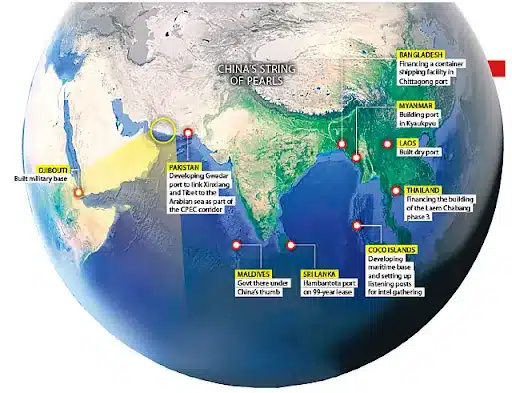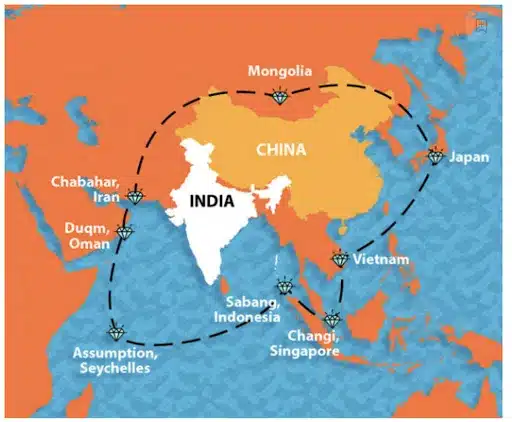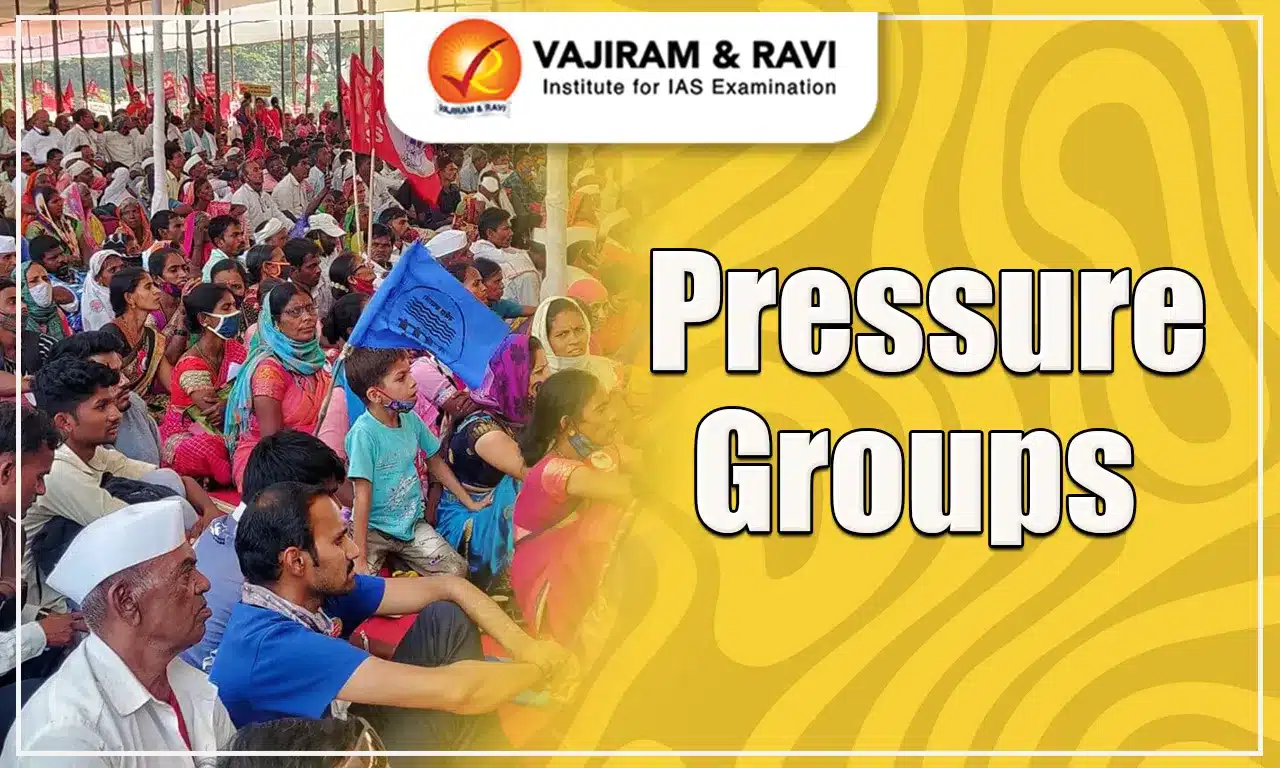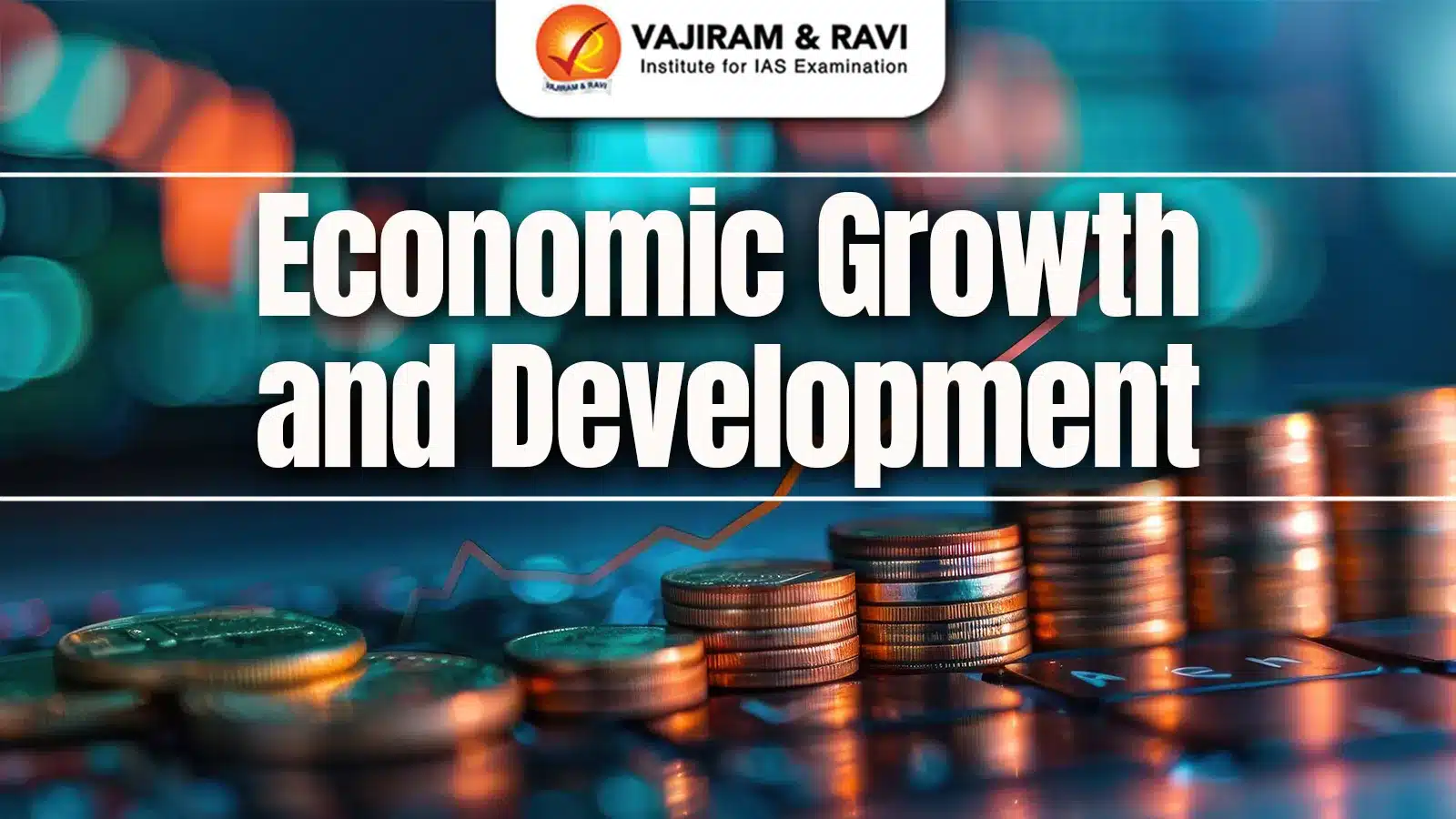String of Pearls is a Chinese strategy to encircle India using military and commercial facilities on land and at sea. The String of Pearls strategy aims to maintain China’s dominance over its neighbour, in this case, India. String of Pearls can significantly impact India, leading to the drain of its economic wealth and diversion of military resources.
String of Pearls focuses mainly on encircling India in the Indian Ocean Region (IOR) by building permanent military and commercial bases, which include Gwadar, Hambantota, Sittwe, etc. India needs to effectively counter the String of Pearls to emerge as the Net Security Provider in the Indian Ocean Region.
String of Pearls Strategy
String of Pearls Strategy refers to the Chinese plan of building a network of military and trade facilities with maritime links to encircle India. String of Pearls stretches from mainland China to the south of Port Sudan (Africa). The term was coined by Booz-Allen-Hamilton in 2004. The major “pearls” in the Indian Ocean include Hambantota (Srilanka), Gwadar (Pakistan), Kyauk Pyu (Myanmar), Chittagong (Bangladesh), etc.
String of Pearls Map
String of Pearls Map shows the location of Chinese bases which encircle India. The main “pearls” in String of Pearls include Djibouti base, Gwadar (Pakistan), Hambantota (Srilanka), Chittagong (Bangladesh), Kyauk Pyu (Myanmar), Coco Islands (Myanmar), etc.
String of Pearls Impact on India
String of Pearls can have an adverse impact on India if not countered properly. The String of Pearls acts as a major strategic challenge in India-China relations, influencing regional dynamics and heightening geopolitical tensions in the Indian Ocean Region. The details are discussed below:
- Endangers Maritime security: China's presence will jeopardize India's maritime security. China is increasing its firepower with more submarines, destroyers, vessels, and ships. This threatens Indian maritime security.
- Reduction in Strategic Clout: India's strategic clout in the Indian Ocean will be reduced even though China does not have any openings in the Indian Ocean; therefore, the Strings of Pearls will lead to China surrounding India and dominating it. Countries that consider India a partner in response to China may find themselves in China's lap.
- Impact on Economy: Indian resources will be diverted to defense and security. As a result, the economy may fail to reach its full potential, slowing economic growth. This may exacerbate instability in India and the entire east and southeast region.
- Geopolitical Tensions: It may lead to the reconfiguration of alliances in the Indian Ocean Region, which may hamper India’s interest in the Indian Ocean
- Instability in the Sub-continent: Chinese support for Pakistan through China Pakistan Economic Corridor (CPEC) and Gwadar Port may result in increased hostility by Pakistan, leading to more instability in India.
String of Pearls India’s Response
String of Pearls requires a strong countermeasure from India to avoid its negative impact and support our growth and development. India’s response includes the Necklace of Diamonds Strategy, increasing economic and security cooperation in the Indian Ocean Region, and using multilateral forums like QUAD. The details are discussed below:
- Necklace of Diamonds Strategy: The Necklace of Diamonds represents India's response to China's growing influence in the Indian Ocean and South China Sea. The strategy includes developing naval bases, improving relations with other countries, and expanding military bases.
- Necklace of Diamonds Strategy is a term coined by India's former foreign secretary Lalit Mansingh while speaking at a think tank in August 2011.
- Diplomacy: India should enhance diplomatic ties with countries in the String of Pearls strategy, engage in open dialogues, and foster regional cooperation to build a united front against potential threats for collective security.
- Re-examine “One China Policy”: India, like many countries, adheres to the 'One China' policy, recognizing the People's Republic of China (PRC) as the legitimate government. This policy maintains diplomatic relations with the PRC, but India could re-examine its approach to counter Chinese influence.
- Quad Cooperation: India is a key player in the Quad, a strategic forum comprising the US, Japan, Australia, and India, aimed at promoting a free Indo-Pacific and tackling shared security and economic issues.
- Economic Engagement: India, to counterbalance the String of Pearls strategy's economic influence, needs to invest in regional economic development and infrastructure projects, potentially forming partnerships with other nations and international organizations.
- Regional Security Cooperation: India needs to enhance regional security cooperation through joint military exercises like the Malabar exercise and improve intelligence sharing to ensure stability and security in the Indian Ocean region.
The tug-of-war to increase influence in the Indian Ocean Region will continue. However, India needs to ensure that Chinese influence is not able to hinder its growth prospects in the region and hamper its ambition of becoming the net security provider in the Indian Ocean Region.
String of Pearls UPSC PYQs
Q.1 The China-Pakistan Economic Corridor (CPEC) is viewed as a cardinal subset of China’s larger ‘One Belt One Road’ initiative. Give a brief description of CPEC and enumerate the reasons why India has distanced itself from the same. (UPSC Mains 2018)
Q.2 China is using its economic relations and positive trade surplus as tools to develop a potential military power status in Asia. In the light of this statement, discuss its impact on India as her neighbour. (UPSC Mains 2017)
Q.3 China and Pakistan have entered into an agreement for development of an economic corridor. What thread does it dispose for India’s security? Critically examine. (UPSC Mains 2014)
Q.4 What do you understand by ‘The String of Pearls’? How does it impact India? Briefly
outline the steps taken by India to counter this. (UPSC Mains 2013)
Q.5 Consider the following countries: (UPSC Prelims 2018)
- Australia
- Canada
- China
- India
- Japan
- USA
Which of the above are among the 'free-trade partners' of ASEAN?
(a) 1, 2, 4 and 5
(b) 3, 4, 5 and 6
(c) 1, 3, 4 and 5
(d) 2, 3, 4 and 6
Ans: (c)
Last updated on December, 2025
→ Check out the latest UPSC Syllabus 2026 here.
→ Join Vajiram & Ravi’s Interview Guidance Programme for expert help to crack your final UPSC stage.
→ UPSC Mains Result 2025 is now out.
→ UPSC Notification 2026 is scheduled to be released on January 14, 2026.
→ UPSC Calendar 2026 is released on 15th May, 2025.
→ UPSC Prelims 2026 will be conducted on 24th May, 2026 & UPSC Mains 2026 will be conducted on 21st August 2026.
→ The UPSC Selection Process is of 3 stages-Prelims, Mains and Interview.
→ UPSC Result 2024 is released with latest UPSC Marksheet 2024. Check Now!
→ UPSC Toppers List 2024 is released now. Shakti Dubey is UPSC AIR 1 2024 Topper.
→ Also check Best IAS Coaching in Delhi
String of Pearls FAQs
Q1. What is the concept of the String of Pearls?+
Q2. What is the objective of China's strategy of String of Pearls?+
Q3. How did India respond to China's String of Pearls?+
Q4. What is the diamond necklace policy UPSC?+
Q5. What is the String of Pearls doctrine?+
Tags: quest string of pearls UPSC International Relations and Institutions Notes



















